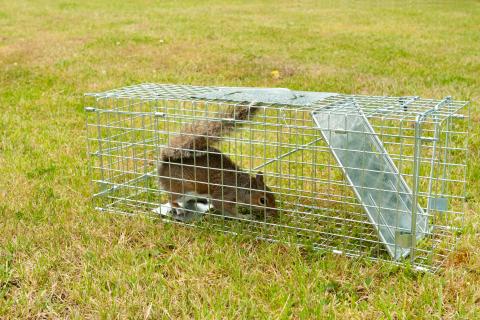Find help...
How to trap and remove squirrels in New Jersey | Tree squirrel
New Jersey > Animal is living inside my chimney > Tree squirrel
How to trap and remove squirrels
Use properly sized cage or box traps:
Fox squirrels - 7-inches x 7-inches x 24-inches
Gray and red squirrels - 6-inches x 6-inches x 19-inches
Flying squirrels - 5-inches x 5-inches x 1-inches” with 1/2-inch x 1-inch mesh
Using improperly sized traps for small squirrels can harm the squirrels and allow escape.
Remove other food sources to make your trapping effort more effective.
Set traps near den holes or along travel routes. Traps placed off the ground should be secured to something solid (e.g. tree branch) and be placed on plywood when on roofs to prevent shingle damage.
Bait traps with apple slices, cracked nuts, or peanut butter.
Pre-bait the traps by tying the doors open for two or three days so squirrels become accustomed to feeding in the traps. Once the squirrels have eaten the bait two or three times, untie the doors and set the trap.
Check the traps twice daily.
Repair any entrances and release trapped squirrels outside.
Female squirrels generally will return for their young. Remove infant squirrel pups by gloved hand or using capture pole/graspers and place outside during daylight, in a cardboard box secured near the sealed entry hole to reunite pups with females.
Translocation of squirrels is not permitted in many states due to disease concerns and low survivorship. Release squirrels in your yard after taking action to minimize future problems.
Never try to grab an adult squirrel with a gloved hand. They will bite through most leather gloves, causing injury.
Laws and regulations to be aware of
While we attempt to provide guidance about state and federal regulations pertaining to specific species and control techniques, we do not provide information about local jurisdictions (city, town, county, etc.) where regulations may be more restrictive, especially as it applies to discharge of firearms, transport of animals or use of trapping equipment. Contact your local city or county government to inquire further. No guarantee is made that information (or lack of information) associated with a species or control technique is completely accurate or current. You should become familiar with federal, state and local laws before beginning any wildlife control activities. |
More solutions for tree squirrel problems




